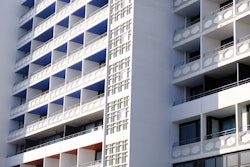
A construction defect case arises when a property owner encounters original construction that fails to meet code or industry standards and has resulted in failures of the product. Where each construction project is going to be different, the cost of restoration from discovered issues can be substantial. For example, one hillside condominium project started showing widespread cracks in its units and evidence of downhill movement. The building is supported largely by formed columns, but expert opinions say that the column footings are undersized and do not conform to the drawings. It's estimated to cost several million to replace or shore the piers and replace the damaged supporting beams.
From single-family homes to large high-rise commercial properties, most construction defect (CD) firms tend to represent the building owner: the investors, the homeowners, the school districts, the public entities, community associations, etc. They are plaintiff-oriented as opposed to the defense firms typically hired by insurance companies to defend construction defect cases representing developers, builders, contractors, and design professionals.
 Tyler P Berding, Berding & Weil LLPBerding & Weil LLP
Tyler P Berding, Berding & Weil LLPBerding & Weil LLP
Concrete Contractor was able to connect and grab a bit of Berding's time for a few questions regarding the condominium renovation market.
CC - How many condominiums are in the U.S.? How many of these will need renovations?
The Department of Housing and Urban Development estimates that more than 5 million households live in condominiums. HUD also estimates that 2.3 million condominium projects were built between 1970 and 2003, so their data is very old. I would estimate that the total now is at least twice that, if not greater.
Half of the existing condominium projects will need extensive renovations in the next 10-20 years. Not all of those will involve concrete restorations; however, depending on new investigations of the many reinforced concrete buildings that have not been the subject of sufficient inspections before the Surfside incident (summer 2021).
“There were no condominiums in the U.S. until the early Sixties, but those built then are approaching 60. Thousands more condominium buildings are approaching 40-50 years of age. The reports on their condition are not good. As they age and if the inevitable decay is deferred or otherwise unaddressed, those buildings will fail to provide safe shelter. With that will come repair mandates from cities and counties that owners cannot or will not meet. The result will be a growing condominium ‘desert’ where many buildings are abandoned.”
—Tyler Berding
Can you explain more about what you mean by a 'condominium desert?'
Condominium buildings have service lives. This little-understood fact means that over a period, usually between 40 and 60 years, these buildings will deteriorate until they are no longer salable or habitable. This occurs because the funding model that accompanies the creation and sale of condominiums leaves the determination of what is “adequate” funding to the discretion of individual owners who have the power to resist attempts by managers to raise funding sufficient to maintain the project over time. This results in a gradually increasing deficit in reserve funding for future projects. It also deprives management of the means to conduct more thorough investigations of all portions of the project, including those where damage can be hidden from surface inspections. The failure of this model means that hundreds of condominium projects built since the nineteen-sixties will eventually reach the end of their service lives and leave the then-owners with few resources to recover their equity from the building. These “zombie” buildings will either be condemned, sold to developers, or abandoned, depending on the severity of the deterioration and whether the site is attractive enough to entice a buyer who will pay enough to liquidate owner equity and any bank financing.
What might be the top 3 or 5 most common types of concrete renovations that will likely be needed?
Driveways, decks, and foundations in wood-frame buildings, and sidewalks, curbs, gutters, and drainage infrastructure. For reinforced concrete buildings, we are just now developing statistics on renovations involving concrete. Interest in those buildings opened dramatically with the collapse of the podium deck and supported tower of the Champlain Towers project in Surfside, Florida, which killed 98 occupants.
Where an HOA might be hesitant to perform “deep building inspections”, where might the responsibility of the concrete contractor/general contractor who built the building end?
Usually, if it doesn’t involve an allegation of fraud, it ends with the running of various statutes of limitation or repose, five to ten years, depending on the state. A finding of fraud can extend that period of liability.
Why would an HOA not want an inspection?
Either they didn’t know they needed an inspection, usually of components that are not visible or accessible, or if the cost of doing an adequate inspection greatly exceeds the available funding and the owners resist proposed assessments.
After construction/renovation of a building, what can contractors do?
Respond to complaints immediately and address them adequately so that the owners have no reason to retain attorneys. The last thing contractors need are attorneys doing their quality control.
While decorative work is likely not going to cause structural damage, are there any “defect” cases in the decorative side of construction?
Trim, and “plant-ons” that were often made of concrete or wood are now made of a foam material that collects water, doesn’t hold paint well, and often fails. Balcony supports enclosed by decorative soffits without adequate ventilation can retain moisture in those enclosed spaces and quickly rot. In 2015 a soffit-enclosed balcony on an apartment house in Berkeley, California, collapsed and killed six students and injured seven others. The balcony had been inspected three times, once by the city, before the collapse. The building was only eight years old.
As one handling construction defect cases, what advice would you give concrete contractors should they be involved in such a situation? What advice would you give concrete contractors to avoid such a situation?
Have an attorney review any proffered sub-contract, so the contractor understands the extent of any indemnity or insurance clauses. Understand the coverage of any owner or contractor-controlled insurance policy. Hire only well-trained craftsmen to execute the design. Read the plans carefully to understand the scope of the contractor’s obligation. Respond to complaints quickly and if the contractor has some responsibility, make every effort to resolve the complaint informally.



















